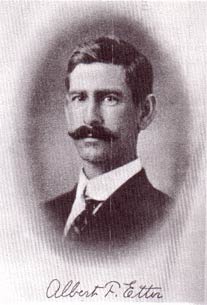
Happy Groundhog Day!
I’ve written before on the value of experimentation and in particular on the worthwhile practice of growing fruit trees from seed.
Recently, while doing my research on growing apples in Florida, I came across the inspiring story of Albert Etter in the following post at Green Mantle Nursery. Good for them for preserving the legacy of a true pioneer!
Check this out:
As a boy growing up on a farm near Ferndale CA, Etter displayed a precocious talent for horticultural experimentation. He combined aptitude with vision at an early age, making his life goal the creation of a new fruit varieties uniquely suited for California and the Pacific Northwest.
While still in his late teens, Albert had the enormous good fortune to stumble onto the piece of land that was to become his ranch and experiment station.
The young Etter discovered this bench of forest land above Bear Creek
during a fishing trip up the Mattole River Valley. Rugged and remote,
the parcel was available for free through the Homestead Act. In 1894
at the age of 22, Albert was able to take possession of the dream place
he came to call Ettersburg. Clearing and improving the land was a formidable task, but he was helped in the work by several of his brothers who homesteaded adjacent parcels. And so a life-long quest for new and better fruit varieties took shape in the wilderness…
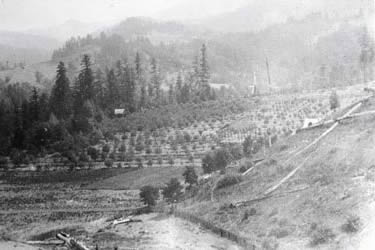
The Ettersburg “Experimental Place” –
Laying out the grid circa 1900
strawberry legacy and the apple legacy. Actually, both projects began
and proceeded more or less simultaneously from the founding of his homestead experiment station.
Etter’s philosophy contradicted the conventional wisdom of the academic
pomologists of his day. While many of these experts regarded him as an
under-educated fool, others, like Dr. George Darrow of the USDA, made the long pilgrimage to Ettersburg to learn from this inspired visionary.
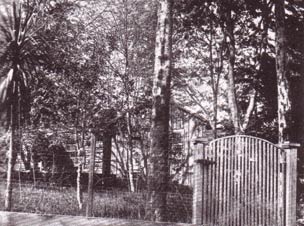
Ettersburg
in its Prime circa 1925
Etter was a remarkably systematic worker with an ambitious agenda.
His apple program began with his growing out a grid of seedlings to serve as understocks. By 1900, he was ready to top-work these trees to several hundred varieties obtained through the new University of California Extension Service. The goal of this trial was to identify varieties that had desirable qualities needed as parents for subsequent breeding experiments. Etter eventually made thousands of crosses, grew out rows of the resulting seedlings, and then grafted wood from these onto his understock trees.

Edward
J. Wickson (1848-1923) – “Father of California Agriculture” and
mentor to Burbank and Etter. A plum from the former and a crab hybrid
from the latter bear his name.
While Etter was waiting for his apple experiments to bear fruit, his
strawberry work made it “big time”. The new strawberry varieties
came to the attention of Edward J. Wickson, California’s leading pomological authority and publisher of Pacific Rural Press. Under Wickson’s media mentorship, Etter and Ettersburg became world famous for important new strawberries. Etter was proclaimed as a hillbilly successor to Luther Burbank, and dubbed “the man who made himself in the woods”.
By the 1920’s, several of Etter’s strawberries were being grown commercially in Oregon, England, New Zealand, and Australia.
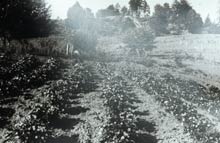 Etter Strawberry Beds circa 1915 |
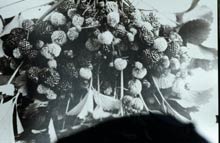 Trebla Strawberry |
Fame, however, did not lead to fortune, at least not for Etter. Others
profited from his new strawberries, but Etter himself did not succeed
as a businessman or nurseryman. Patent rights did not apply to plant
hybridization until 1930. Isolated from railroad and trucking routes,
Ettersburg was not well suited for berry commerce.
At any rate, Etter soon shifted his hopes and horticultural attention
almost exclusively to his growing list of new apple varieties…
CLICK HERE to keep reading over at Green Mantle Nursery’s site.
Shop at Amazon and support Florida Survival Gardening


5 comments
Its unfortunate that modern monoculture doesn't promote diversified varieties. I understand the want/need to have pretty shelf fruits but seriously does a bruise here and there make a fruit inedible? I don't think so. Everyone should start planting some seeds!
Yes. That's where individuals come in. We can make things happen on a small scale because we're not bound by the need to make a profit or sell to an uneducated public.
Right on man! I once read an article on citrus not growing true to type. The guy was stating that it was misinformation spread by the citrus industry to sell more trees. He went on to prove his point by saying that a) citrus in a yard is stand alone so it probably got cross pollinated by another completely different type therefore not a true grower and b) however, commercial citrus is grown in huge orchards of all like trees therefore it could only have bred with a like type citrus therefore a high probability of growing true to type. Its all simple biology. Not confident that those statements are true but it seems logical and goes against the norm. Either way why not grow random seeds it may be something new and amazing!
Etter is one of my heros for sure and would be in my top 5 historical figures to meet. Albert Etter and Royal Raymond Rife are first choices, no question. The other 3 I'd have to think about. It's really interesting to read Etter's letters to Wickson's publication, the Pacific Rural Press, about his progress in breeding and such. Sometime of an evening, search "albert etter" in google books to read some of that old stuff. Where apples are concerned, growing straight from seed into a tree is not the best option. Given their genetic variability, there actually IS a good chance you will be disappointed after waiting perhaps as long as a decade or more for fruits to form. There is a place for that in the back 40, but more often than not, it's better to grow seedlings and graft onto an existing tree or onto dwarfing rootstocks for faster fruiting. You can also fit a lot more in that way. I have my apple breeding experiments on bud 9 dwarfing stock in rows at 12 inches in the row, 6 feet apart. In every one of them, one parent is a red fleshed apple from Albert Etter's efforts. Would that he had another lifetime!
https://turkeysong.wordpress.com/2013/04/03/apple-breeding-part-1-everyone-knows-you-cant-do-it-right/
When previous reading your posts on the topic, I was interested by the fact that fruiting was sped up by grafting onto a dwarfing rootstock. In my work with loquats I'm only dealing with a six-year juvenile period which helps. I'm just getting started, however. If I can get them to take on pyracantha, I'll bet that speeds the fruiting significantly. As it is, I'm collecting varieties from trees with favorable characteristics and grafting them onto my own seedling rootstocks. Just picked up a bunch of budwood from someone today after a local nursery owner told me that her tree (likely a seedling) had some of the largest and sweetest loquats he'd ever seen. I'm going to graft onto my largest tree and see if they'll fruit for me in the next year or so.
Comments are closed.